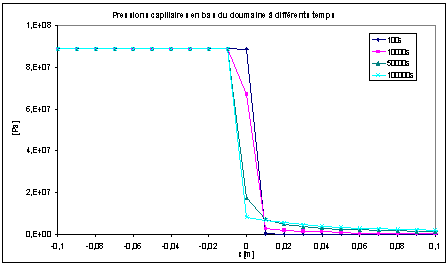5. D modeling#
5.1. Characteristics of modeling D#
D_ PLAN_HH2S modeling, this modeling corresponds to Finite Element modeling. Coupling LIQU_AD_GAZ. We use a mesh composed of 100 elements QUAD8
We are immiscible and we use an infinite Henry coefficient of \({10}^{20}{\mathrm{Pa.mol}}^{-1}\mathrm{.}{m}^{3}\),
Discretization in time:
\(\mathrm{1000s}\) in 20 steps of time
\(10000s\) in 20 steps of time
1 month in 20 steps of time
2 months in 20 steps of time
6 months in 40 steps of time
1 year in 50 steps of time
10 years in 50 steps of time
50 years in 50 steps of time
100 years in 50 steps of time
500 years in 50 steps of time
1000 years in 50 steps of time
5000 years in 50 steps of time
10,000 years in 50 steps of time
100,000 years in 50 steps of time
1,000,000 years in 50 steps of time
5.2. Results#
The figures below show the gas pressure profiles and capillary pressures along the bi-material at different times:


As with the \(A\) finite element modeling, the gas pressure peak at the interface is very important here. It is obvious that finite elements are less adapted to this type of problem than finite elements.
5.3. Tested values#
This test case has no reference value, so we make it a non-regression case.
Tests are carried out on two values:
Points \((x,y)\) |
Time ( \(s\) ) |
\(\mathit{PRE1}\) Aster |
\(\mathit{PRE2}\) Aster |
Relative error allowed |
\(\mathrm{N111}\) |
\(100\) |
\(37569\) |
\(-6536\) |
\(1\text{\%}\) |
\(100000\) |
\(4.486{10}^{6}\) |
\(-12413\) |
\(1\text{\%}\) |